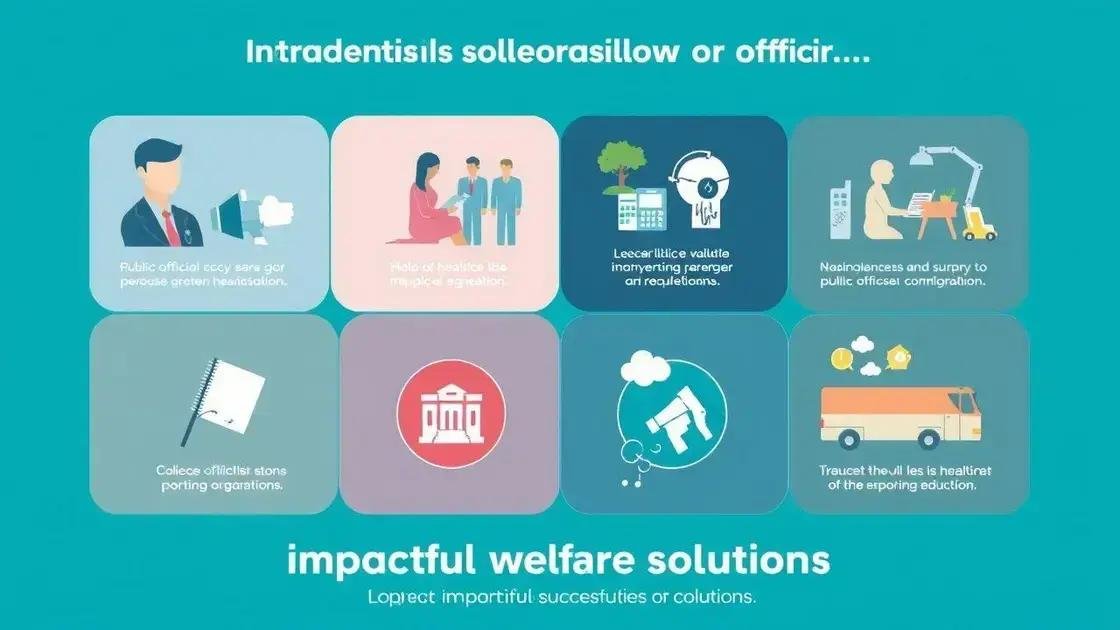The hybrid public-private welfare delivery model combines the strengths of public agencies and private organizations to improve social services, offering enhanced efficiency, innovation, and better resource utilization while addressing community needs effectively.
The hybrid public-private welfare delivery model is reshaping how we think about social services. What happens when the strengths of both sectors combine? Let’s explore the exciting possibilities!
Understanding the hybrid model
To fully grasp the hybrid public-private welfare delivery model, it’s essential to understand its core principles and how they come together. This model blends the strengths of both public and private sectors, creating a unique approach to delivering social services.
The hybrid model focuses on collaboration, combining resources and expertise from both sides to improve outcomes for communities. By sharing responsibilities, this approach often leads to better efficiency and improved service delivery.
Key components of the hybrid model
This model typically includes several key components that characterize its operation:
- Partnerships: Establishing strong partnerships between government and private entities is crucial.
- Resource Sharing: Both sectors share resources, knowledge, and capabilities.
- Focus on outcomes: The primary goal is to achieve better outcomes for individuals and communities.
- Flexibility: The model allows flexibility in adapting to changing needs and circumstances.
Understanding these components can help individuals appreciate how the model operates and its potential benefits. For example, one aim is to reduce the burden on public agencies by integrating private sector efficiency.
Furthermore, examining real-life applications of the hybrid model illustrates its effectiveness. For instance, in many regions, local governments partner with non-profit organizations to deliver health services. This collaboration results in improved access and quality of care, showcasing the benefits of the hybrid approach.
When we look at the operational structure, the hybrid model fosters innovation. Public agencies may struggle with bureaucratic processes, while private organizations often excel in flexibility. Merging these strengths cultivates an environment ripe for creative solutions.
Investing in this hybrid approach not only addresses current challenges but also prepares communities for future needs. The model encourages a culture of continuous improvement, ultimately leading to a more responsive welfare system.
Key benefits of hybrid public-private welfare
The hybrid public-private welfare model offers numerous advantages that enhance the effectiveness of social services. By combining efforts from both sectors, it creates a more robust support system for communities.
One of the main benefits is improved efficiency. With private organizations often having more flexible structures, they can adapt quickly to changing needs, allowing for timely interventions. This can lead to faster service delivery and better responses in critical situations.
Enhanced Resource Utilization
Another significant advantage is the better utilization of resources. Public agencies often face budget constraints, while private entities can tap into alternative funding sources. Together, they can pool their resources to achieve more.
- Cost-sharing: Public and private partners can share costs, reducing the financial burden on taxpayers.
- Access to expertise: Private organizations bring specialized knowledge that can improve service quality.
- Innovation: Collaborative efforts foster innovation, leading to new ideas and approaches in welfare delivery.
- Broader reach: Combining resources can expand the geographical and demographic reach of services.
Furthermore, the hybrid model promotes accountability and transparency. When both sectors work together, they create mechanisms to hold each other accountable, ensuring services are delivered effectively and ethically. This collaborative oversight can enhance public trust in welfare systems.
The model also encourages a focus on outcomes rather than processes. By prioritizing results, partners are motivated to evaluate and improve their services continually. This leads to a culture of excellence, where every participant strives for the best possible outcome for individuals and communities.
Ultimately, the hybrid public-private welfare model provides a comprehensive approach to addressing social needs. Its ability to blend resources, knowledge, and strengths from both sectors paves the way for innovative solutions and improved welfare services.
Examples of successful implementations

Numerous examples showcase the success of the hybrid public-private welfare delivery model, highlighting its effectiveness in various sectors. These implementations provide valuable insights into how this approach can improve social services in different communities.
One notable instance is the partnership between a local government and non-profit organizations in delivering healthcare services. This collaboration allowed for greater access to essential health services, particularly in underserved areas. The non-profit’s expertise in community health and the government’s resources led to impactful health programs.
Education Initiatives
Another successful implementation involves a hybrid approach in education. In several regions, public schools have partnered with private education providers to enhance learning opportunities. This collaboration has resulted in improved curriculum offerings and increased student engagement. By merging resources, schools can access innovative teaching methods and technologies.
- Common core programs: Programs that provide standardized educational support to various student demographics.
- After-school programs: Enhancing extracurricular activities with private sector involvement.
- Scholarship programs: Financial assistance for low-income students, funded by private donations.
- Teacher training: Joint initiatives to improve educator skills through shared resources.
Another example can be seen in public transportation. In certain cities, local governments have partnered with private companies to improve transit services. This collaboration not only enhances service efficiency but also leads to innovative solutions in transportation logistics.
The hybrid model also emerges in social welfare programs addressing homelessness. Cities have collaborated with private charities and organizations to develop housing programs that support transitional living. These collaborations have shown promising results in reducing homelessness and improving overall community welfare.
These examples illustrate the potential of the hybrid model to provide effective solutions across different areas of social services. By leveraging the strengths of both the public and private sectors, communities can achieve their goals more effectively and create sustainable change.
Challenges in hybrid welfare delivery
While the hybrid public-private welfare delivery model presents various benefits, it also faces several challenges that can hinder its effectiveness. Understanding these challenges is crucial for successful implementation.
One of the primary issues is the potential for conflicting goals between public and private partners. Public agencies often aim for broad social equity, while private entities may focus on profitability. These differing priorities can lead to tensions in decision-making processes.
Resource Allocation
Another challenge involves resource allocation. Both sectors may have different understandings of what it means to fund and support programs. This can result in miscommunications or disagreements about how funds should be used. For example, public entities might prioritize long-term sustainability, whereas private partners might lean toward short-term impacts.
- Budget constraints: Limited funding can lead to reduced program effectiveness.
- Competition for resources: Partner organizations may compete for the same funding sources, causing conflicts.
- Misaligned incentives: Different reward structures can affect collaboration and outcomes.
- Accountability issues: Ensuring that both sectors are accountable for their roles can be difficult.
In addition, stakeholder engagement can pose a challenge. Building relationships between the public and private sectors requires effective communication. If stakeholders are not engaged properly, it may lead to a lack of community support and trust.
Moreover, regulatory challenges can complicate joint efforts. Different regulations, compliance standards, and reporting requirements across public and private sectors can create hurdles for collaboration. Navigating these complexities requires careful planning and continuous dialogue between all parties involved.
Lastly, assessing the outcomes of hybrid programs can be difficult. Setting clear metrics for success is essential, but determines these metrics can vary widely between public and private partners. This variance can hinder the effective evaluation of programs.
Future outlook for hybrid models
The future outlook for hybrid public-private welfare models suggests exciting possibilities as communities continue to seek effective solutions for social challenges. As more stakeholders recognize the value of collaboration, these models are likely to gain traction and evolve.
One key area of growth is the expansion of technology integration. With the rise of digital tools and platforms, hybrid models can leverage technology to enhance service delivery. For instance, telehealth services can combine public health resources with private sector innovation, making healthcare more accessible.
Increased Collaboration
Moreover, we can expect to see increased collaboration across sectors. As public agencies and private organizations work together, they will learn more about each other’s strengths and weaknesses. This understanding will foster an environment of continuous improvement, where best practices are shared to enhance overall effectiveness.
- Cross-sector partnerships: More collaborations will emerge, combining resources to address complex social issues.
- Shared data: Improved data sharing among partners can lead to better decision-making.
- Innovation hubs: Establishing centers for innovation will encourage new ideas and solutions.
- Community involvement: Engaging communities will be crucial for tailoring programs that meet local needs.
Additionally, the hybrid model’s adaptability will be a significant advantage in facing new challenges. As societies change, these models can adjust their approaches to meet evolving needs. This flexibility will be critical in areas like climate change, where integrated responses from both sectors are essential.
Furthermore, funding opportunities for hybrid models are likely to increase as governments and foundations recognize their potential to deliver results. Investment in these initiatives can lead to more sustainable welfare programs that better serve populations in need.
Finally, as awareness of social issues continues to grow, public demand for effective and equitable solutions will push hybrid models to the forefront. This increased emphasis on accountability and outcomes will drive innovation and improvement in welfare delivery strategies.
FAQ – Frequently Asked Questions about Hybrid Public-Private Welfare Models
What is a hybrid public-private welfare model?
A hybrid public-private welfare model combines resources and expertise from both public agencies and private organizations to enhance social services and improve outcomes for communities.
What are the key benefits of this model?
The main benefits include increased efficiency, better resource utilization, enhanced innovation, and improved accountability in service delivery.
What challenges do hybrid models face?
Challenges include conflicting goals between sectors, resource allocation issues, stakeholder engagement difficulties, and regulatory complexities.
What does the future hold for hybrid welfare models?
The future looks promising with increased collaboration, technology integration, and a stronger focus on community engagement and sustainable solutions.

